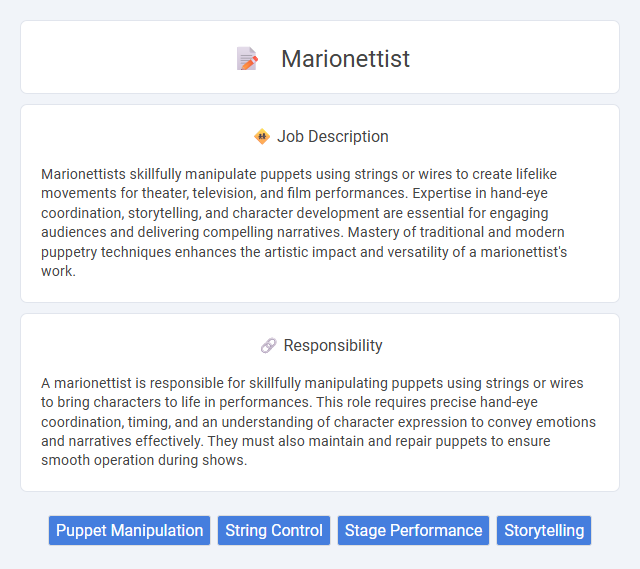
Marionettists skillfully manipulate puppets using strings or wires to create lifelike movements for theater, television, and film performances. Expertise in hand-eye coordination, storytelling, and character development are essential for engaging audiences and delivering compelling narratives. Mastery of traditional and modern puppetry techniques enhances the artistic impact and versatility of a marionettist's work.
Individuals with strong hand-eye coordination and patience are likely to be well-suited for a career as a marionettist, as the role demands precise manipulation of strings and detailed control over puppet movements. Those who thrive in creative environments and enjoy storytelling may find the job fulfilling, while individuals lacking fine motor skills or who struggle with sustained concentration might face challenges in this profession. It is probable that people comfortable with performance and audience interaction could adapt more easily to the dynamic aspects of marionettistry.
Qualification
Marionettists require strong manual dexterity and exceptional hand-eye coordination to manipulate puppets effectively. Proficiency in voice modulation and storytelling enhances performance to engage diverse audiences. Formal training in theater arts or puppetry, combined with experience in improvisation, significantly improves skill and career opportunities.
Responsibility
A marionettist is responsible for skillfully manipulating puppets using strings or wires to bring characters to life in performances. This role requires precise hand-eye coordination, timing, and an understanding of character expression to convey emotions and narratives effectively. They must also maintain and repair puppets to ensure smooth operation during shows.
Benefit
A marionettist may experience significant creative fulfillment and joy from bringing puppets to life, potentially enhancing personal satisfaction and artistic expression. The profession could offer opportunities for flexible schedules and diverse performance settings, contributing to a balanced work-life dynamic. Financial benefits might vary widely depending on skill level, reputation, and demand within local entertainment or educational markets.
Challenge
Working as a marionettist probably involves mastering intricate control over puppet movements, which can be quite challenging due to the complexity of strings and joints. The coordination required to convey emotions and tell stories effectively through a marionette may present a steep learning curve. Successfully overcoming these challenges could lead to a highly rewarding and unique performance experience.
Career Advancement
Marionettists can enhance their career by mastering advanced puppetry techniques and diversifying their performances across theater, television, and film industries. Building a strong portfolio with unique marionette designs and storytelling skills increases opportunities for higher-profile projects and collaborations with renowned directors. Networking within performing arts communities and participating in international puppetry festivals further propels career growth and recognition.
Key Terms
Puppet Manipulation
Marionettists specialize in the intricate art of puppet manipulation, skillfully controlling strings or rods to bring lifelike movements to puppets. Mastery of coordinated hand movements and precise timing is essential for creating realistic gestures that engage audiences. Expertise in various puppet types, including marionettes, hand puppets, and shadow puppets, enhances performance versatility and storytelling depth.
String Control
A Marionettist specializes in manipulating string-controlled puppets to create lifelike movements and expressions, requiring precise hand-eye coordination and dexterity. Mastery of string control enables seamless articulation of limbs, head, and body, bringing characters to life in theatrical performances, films, and television. Expertise in tension management and timing is essential for smooth, responsive puppet operation and storytelling.
Stage Performance
Marionettists specialize in the skillful manipulation of puppets during stage performances, bringing characters to life with intricate hand movements and precise control. Their expertise enhances storytelling by combining visual artistry with synchronized dialogue and music, captivating audiences with dynamic and emotive expressions. Mastery of stage presence and timing is crucial to create seamless interactions between puppets and performers, elevating theatrical productions.
Storytelling
Marionettists expertly manipulate puppets to bring stories to life through precise movements and expressive gestures, captivating audiences with vivid visual narratives. Mastery of character voices and timing enhances the immersive storytelling experience, allowing complex emotions and plots to unfold seamlessly. This artistry requires a deep understanding of pacing, drama, and audience engagement to transform scripted tales into compelling live performances.
 kuljobs.com
kuljobs.com